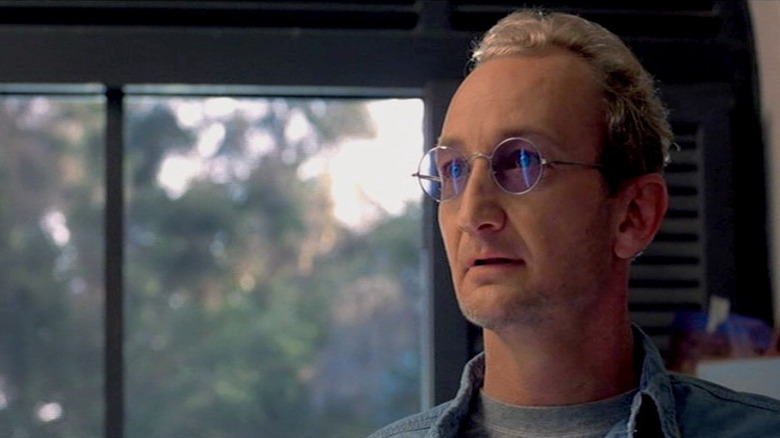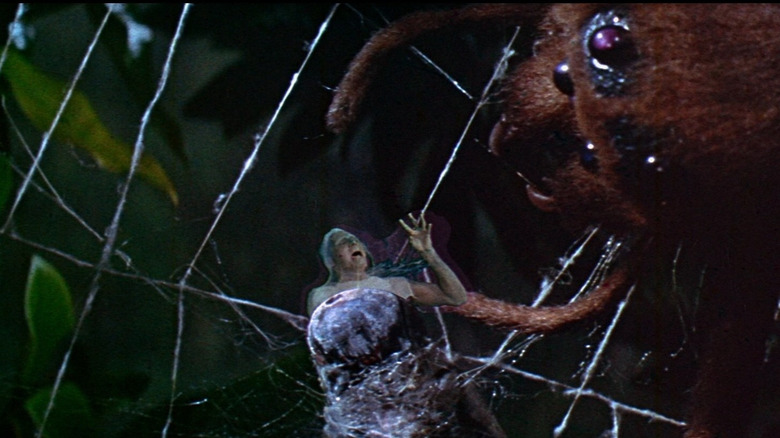The Budget Forced Wes Craven's New Nightmare To Scrap A 'Brilliant' Robert Englund Scene
Seven entries deep into its franchise, "Wes Craven's New Nightmare" not only brought Freddy Krueger (Robert Englund) back for more slicing and dicing, but the dream demon had more agency than previously allowed. A more menacing antagonist than he was in Craven's 1984 original "A Nightmare on Elm Street," this Freddy reaches his bladed glove beyond Elm Street and the screen itself to wink at jaded audiences who, by 1994, are genre experts.
"New Nightmare" is cognizant of the movies and of Freddy as a character; "Elm Street" heroine Heather Langenkamp and Craven play themselves, reckoning with the films that brought them success. Nightmares prompt Craven to resurrect Freddy in a new screenplay, but you can't bring back Freddy without consulting with the man under the burn prosthetics. So, Robert Englund has a role in "New Nightmare" as himself as well, an actor reluctant to don the striped sweater again for fear of being typecast. It's a quick appearance and a sudden disappearance, which Englund explained as a budgetary constraint in an interview with Inverse:
"I play myself in the film and I'm having a nightmare. I'm in bed with my wife up in the Hollywood Hills in my Spanish mansion — which I don't own, but that was Wes's imagination — and I'm tossing and turning and we go into my nightmare. And my nightmare was about whether I was trapped in the role of Freddy. In the scene, Robert Englund is in a spider's web being cocooned by a giant black widow. And on the underbelly of the black widow are red and green stripes, the same color stripes as Freddy's sweater. I thought it was a brilliant symbolic sequence, you know, that I was worried about my career at the time. But we never shot it, we ran out of money."
Fetch the pest spray
One thing about the "Nightmare on Elm Street" movies is that all dreams depicted have high interpretive value. The kids in the highly popular third entry "A Nightmare on Elm Street 3: Dream Warriors" are empowered when they sleep, even as Freddy stalks them. For instance, Will Stanton, bound by a wheelchair in his waking hours, gains wizard-like faculties when he sleeps, making him a tougher target for Freddy to kill. Dreams can also reflect their victims' fears and hang-ups; a model falls asleep at the dinner table and Freddy force-feeds her before throttling her in the fifth entry, "The Dream Child."
In "New Nightmare" (which Robert Englund ranks as his favorite of the film series), Englund's dream is more than an overt reference to the shocking ending of "The Fly." While some time is dedicated to Englund's unease about Freddy (Craven makes it a point to show a bleak painting of Englund's, covered in anguished screaming mouths), the unfilmed sequence underlines the actor's career anxieties. Typecasting can shackle a performer to a genre or niche for life — just ask Boris Karloff or Bela Lugosi.
Those lamenting the spider scene that never happened can still take comfort in "A Nightmare on Elm Street 4: The Dream Master" for creepy-crawly-related thrills. Rejoice and recoil at the incredible practical effects on display as gym rat and entomophobe Debbie Stevens (Brooke Theiss) gets the Freddy treatment. While lifting weights, her limbs deteriorate and shed to reveal cockroach arms, prompting her to flee right into what turns out to be a giant roach motel, which Kruger squishes with glee.
In a franchise filled with a thousand ways to die, hers is one of the gnarliest and for a simple reason — bugs are universally gross.

